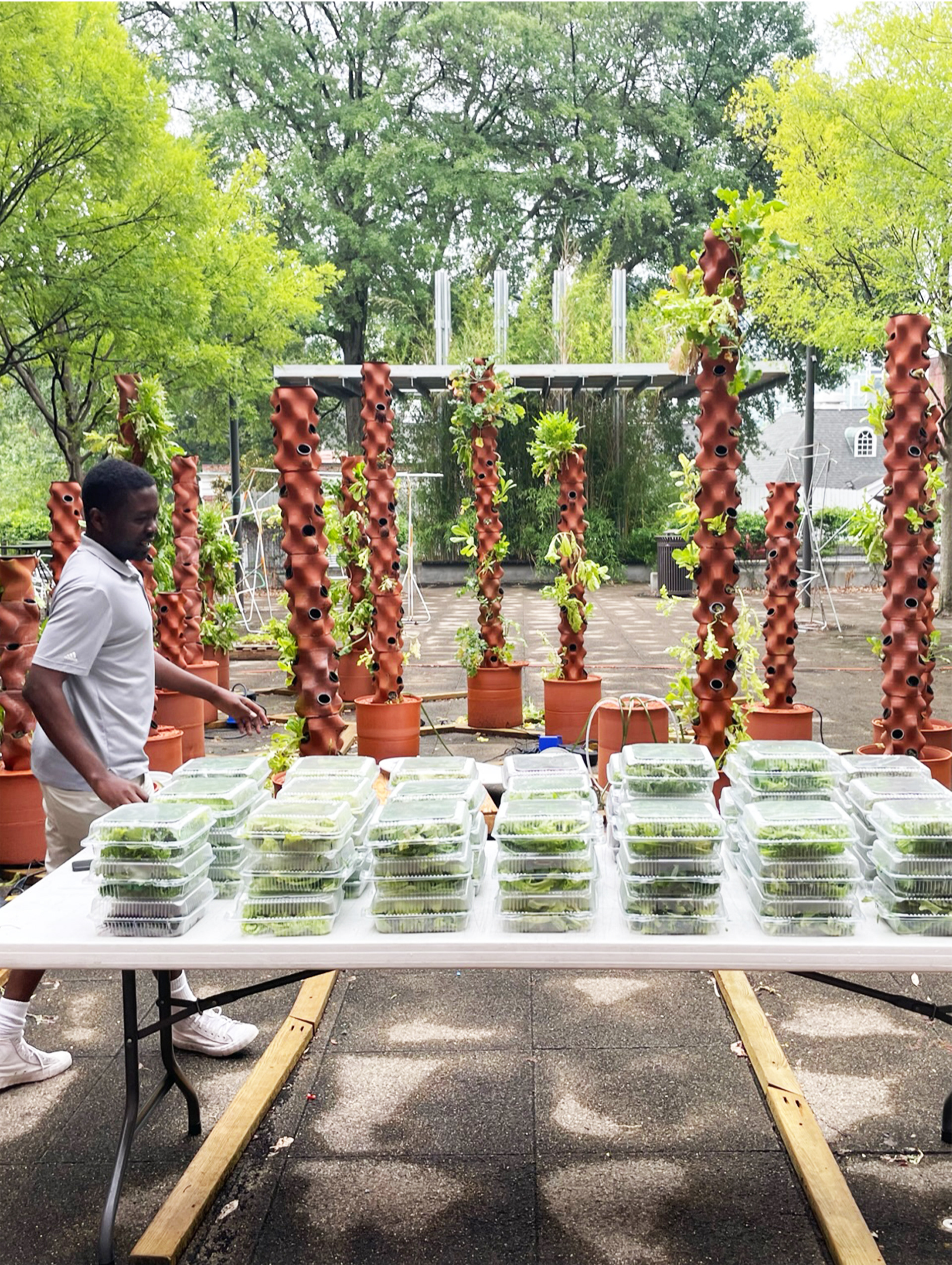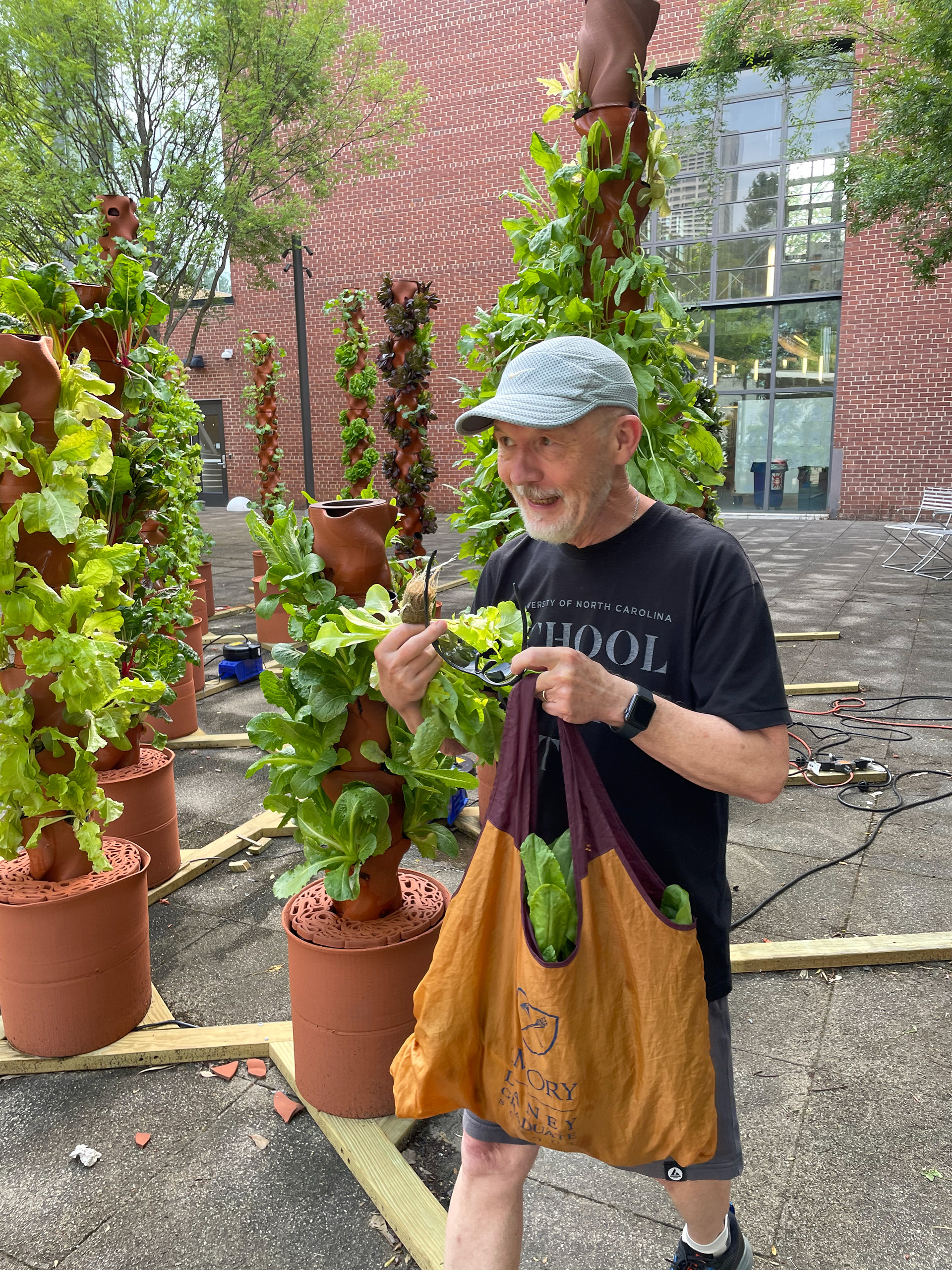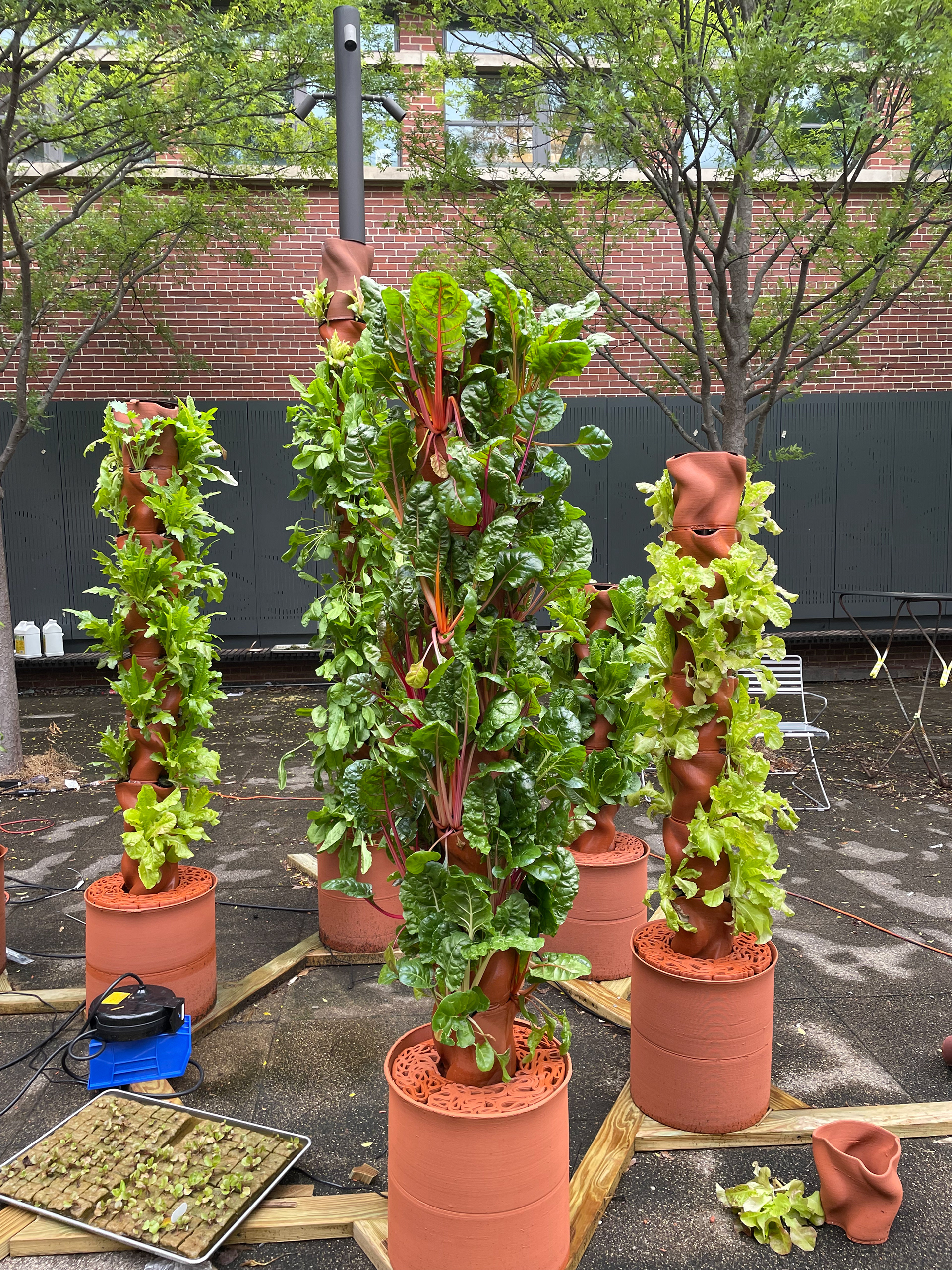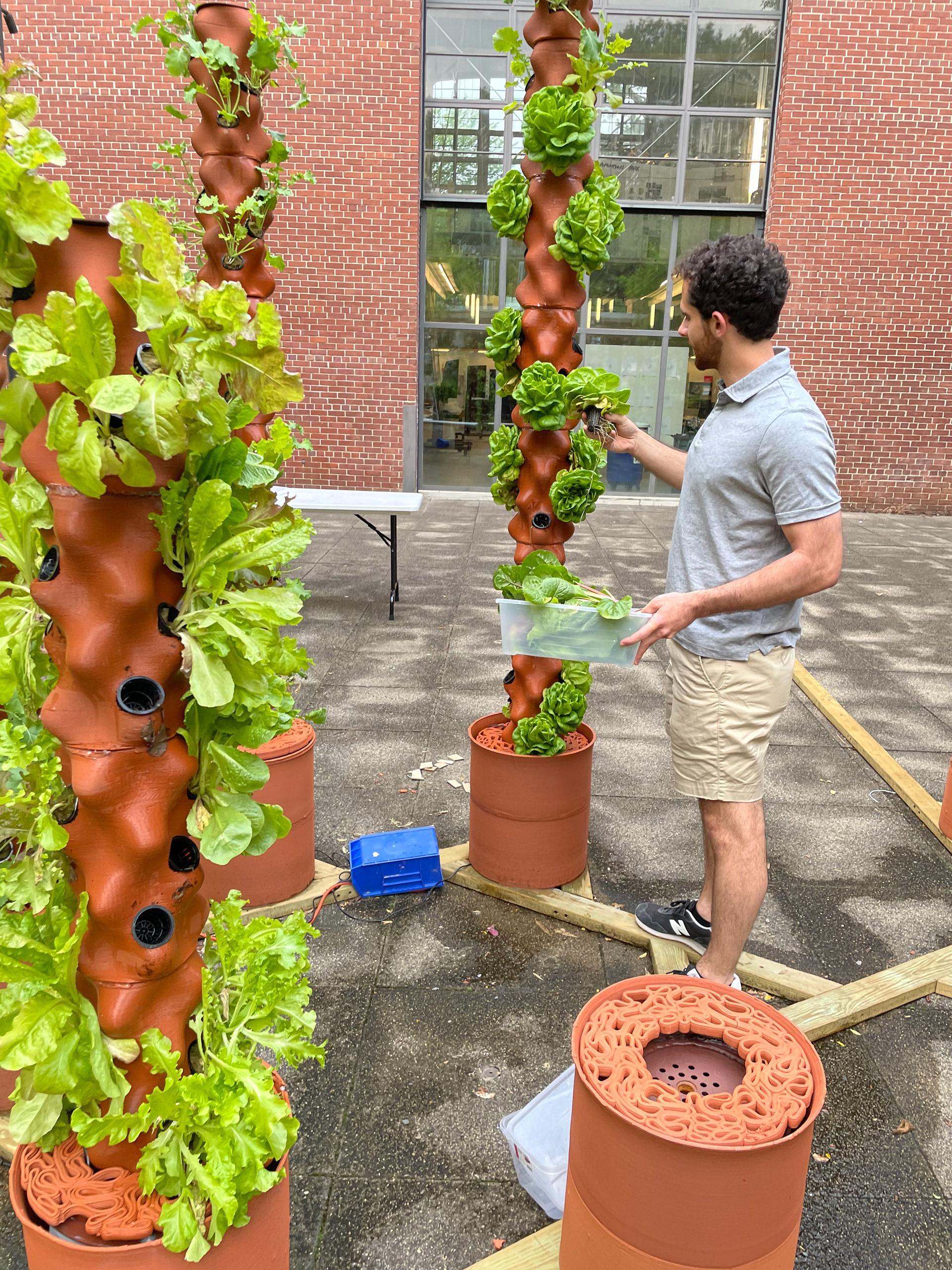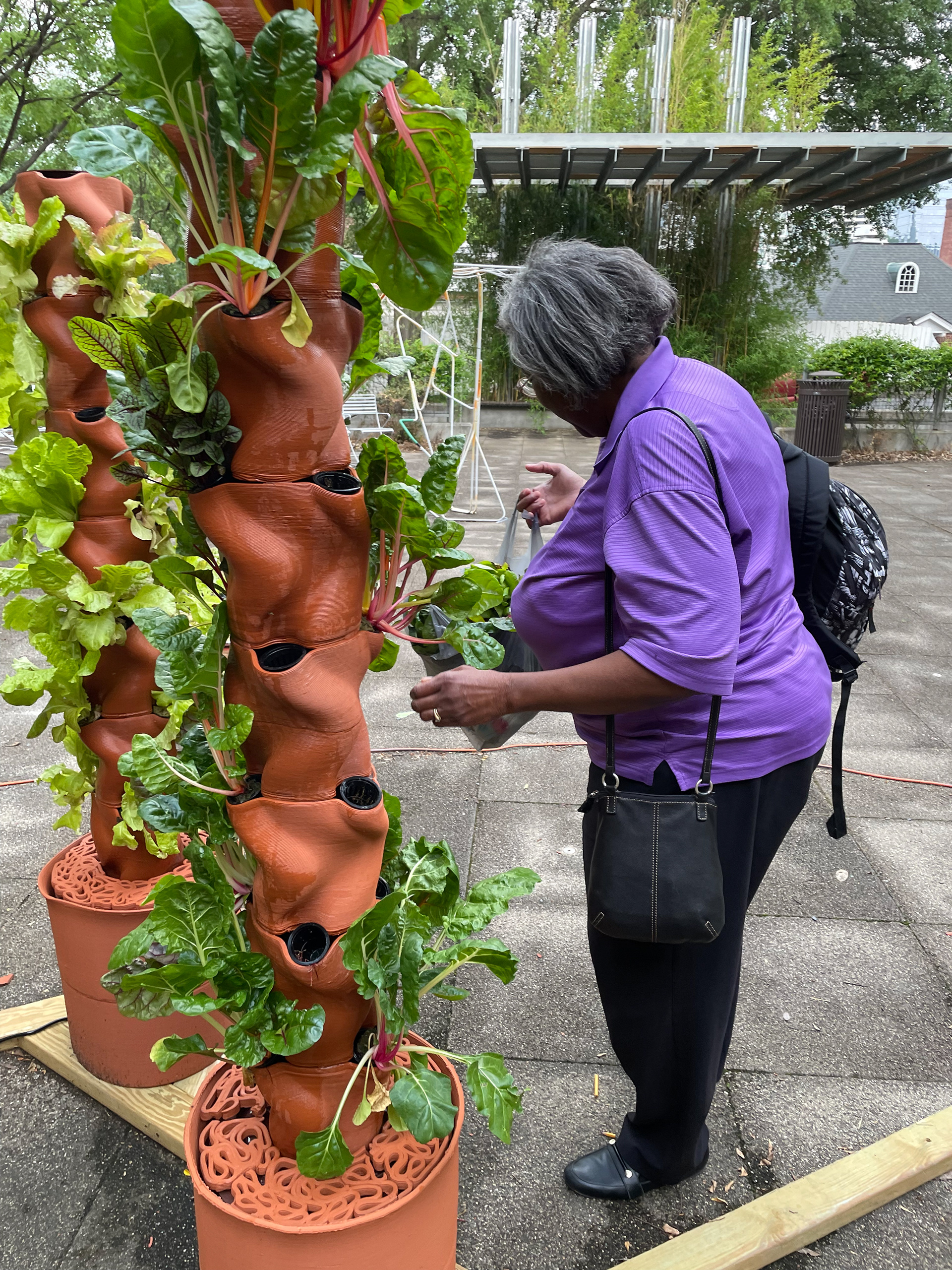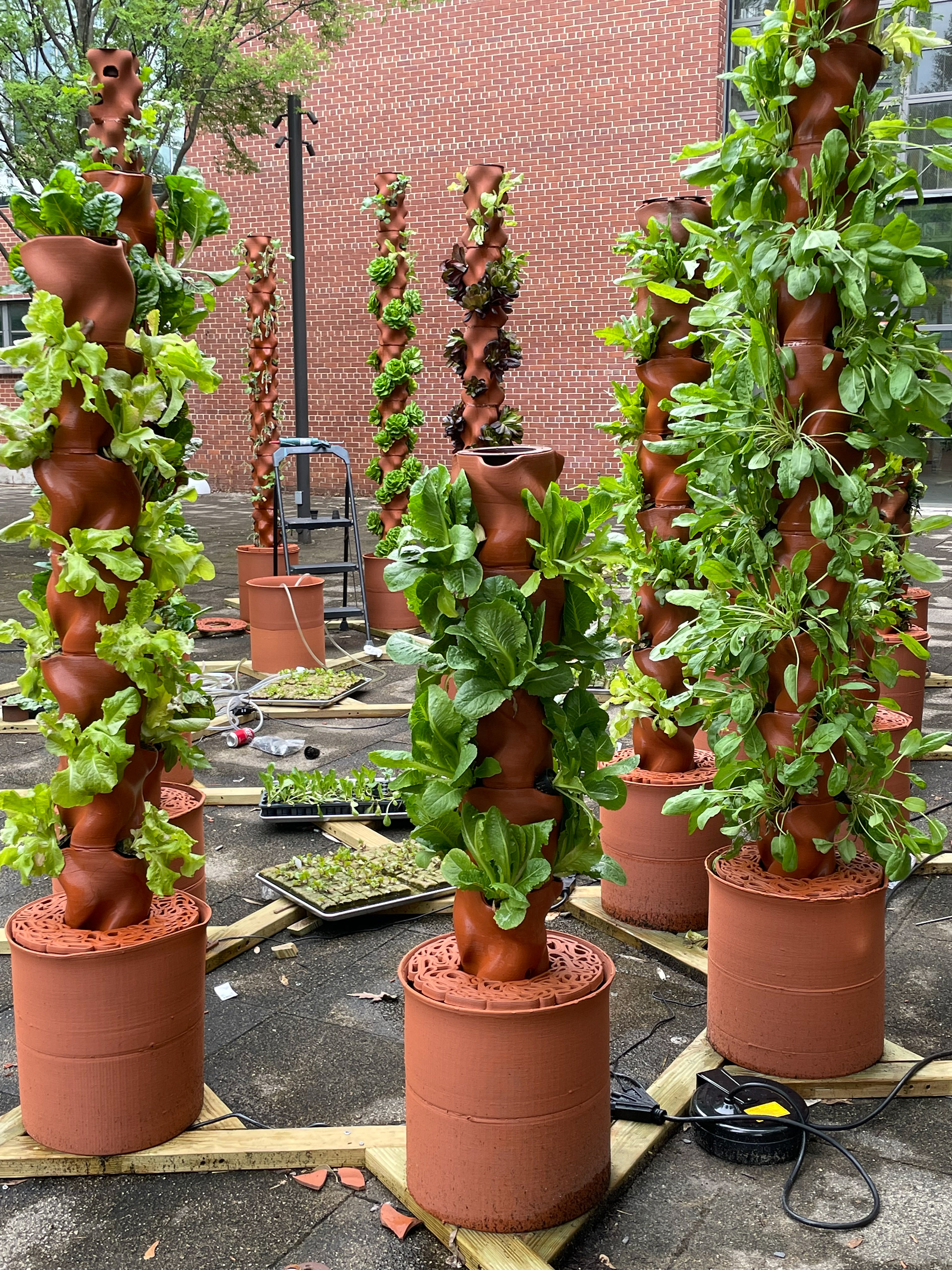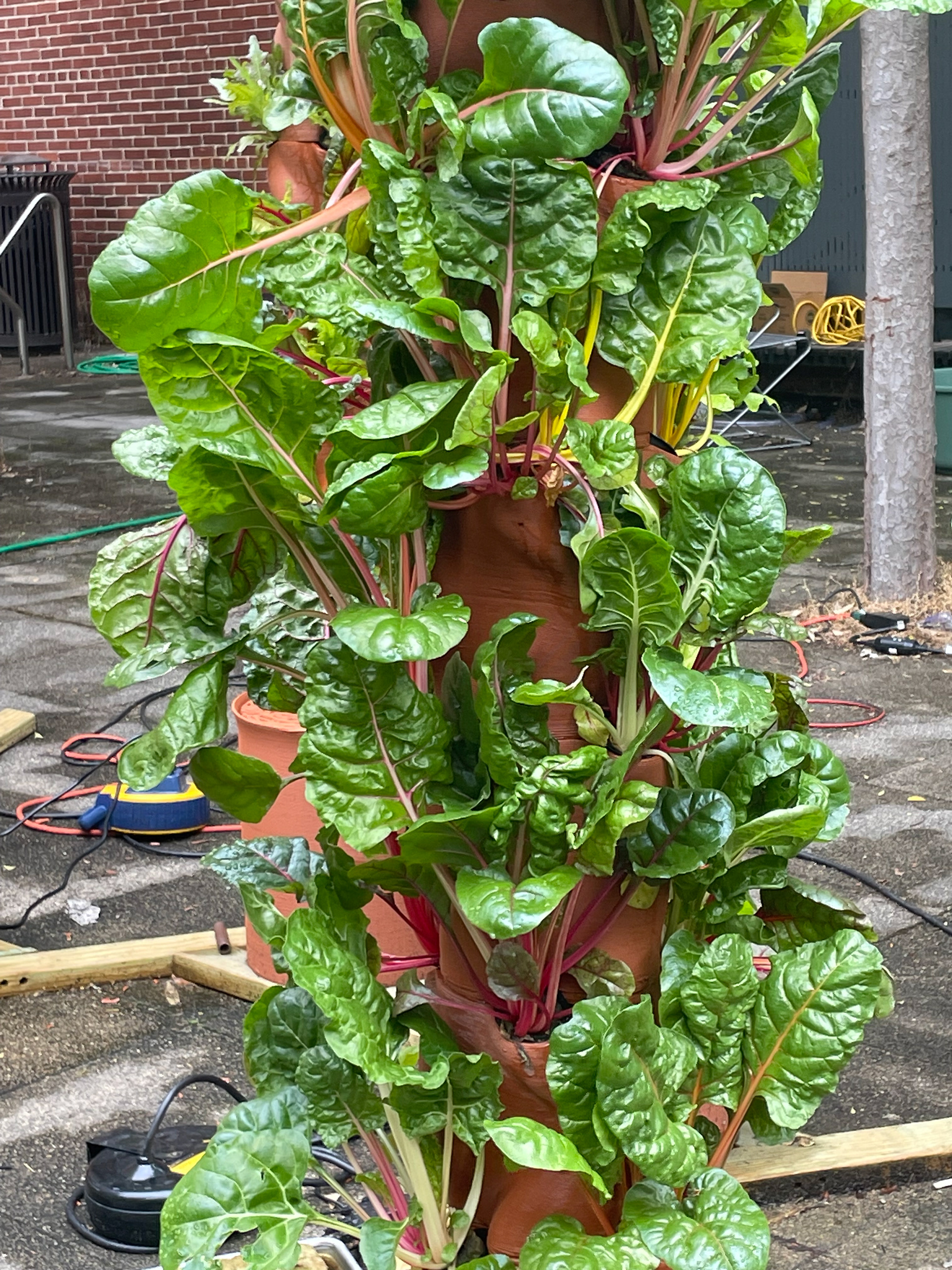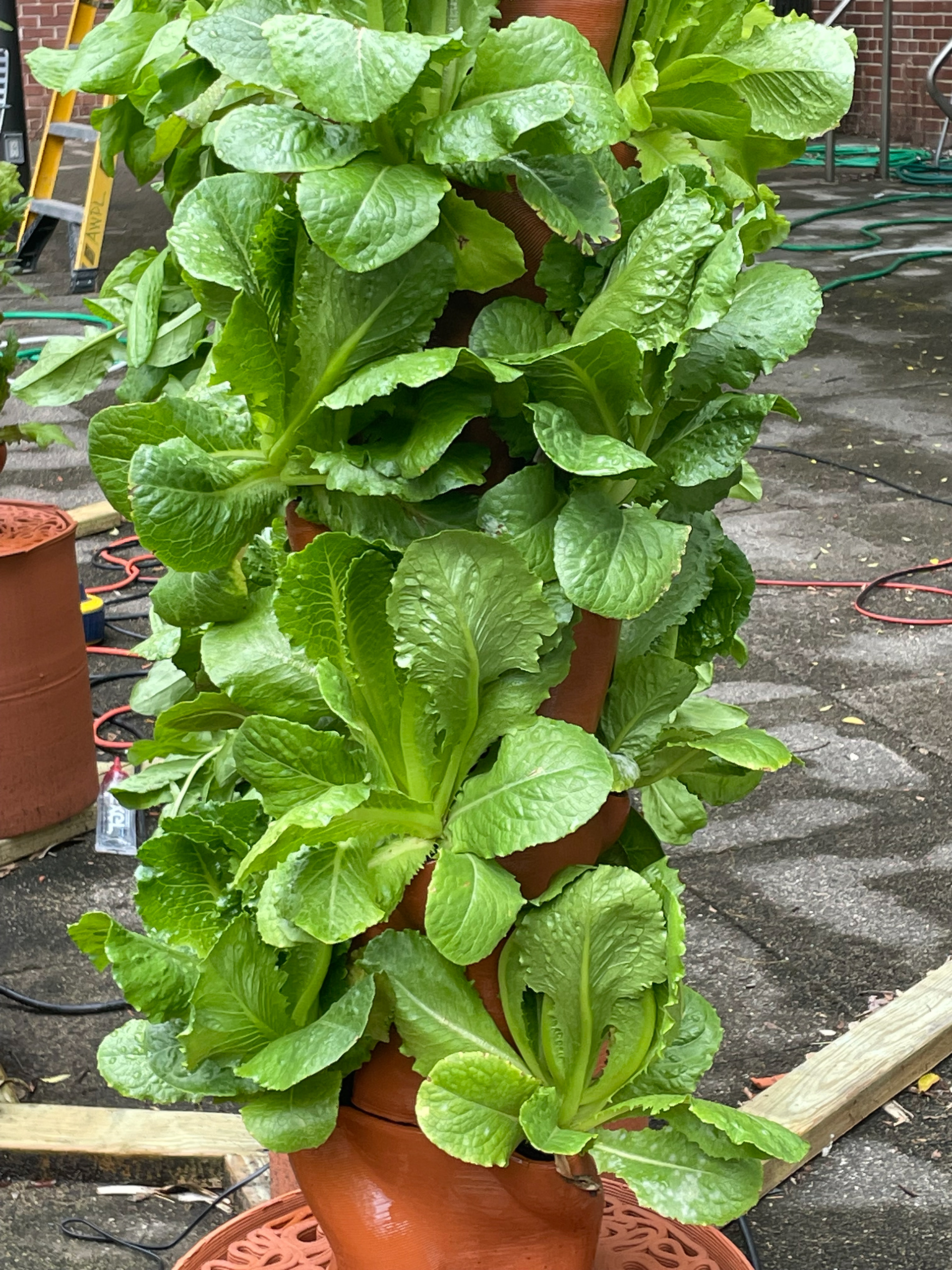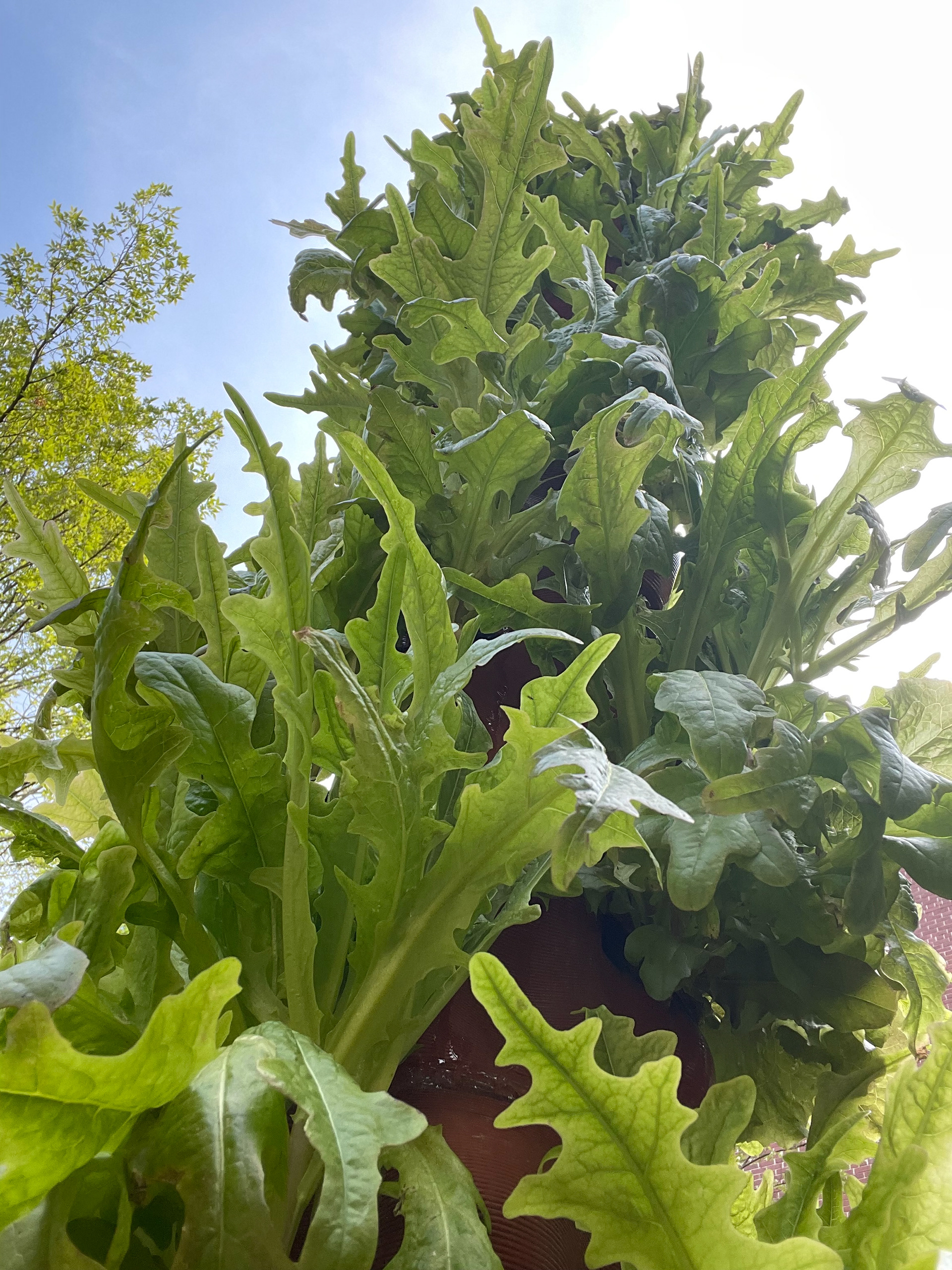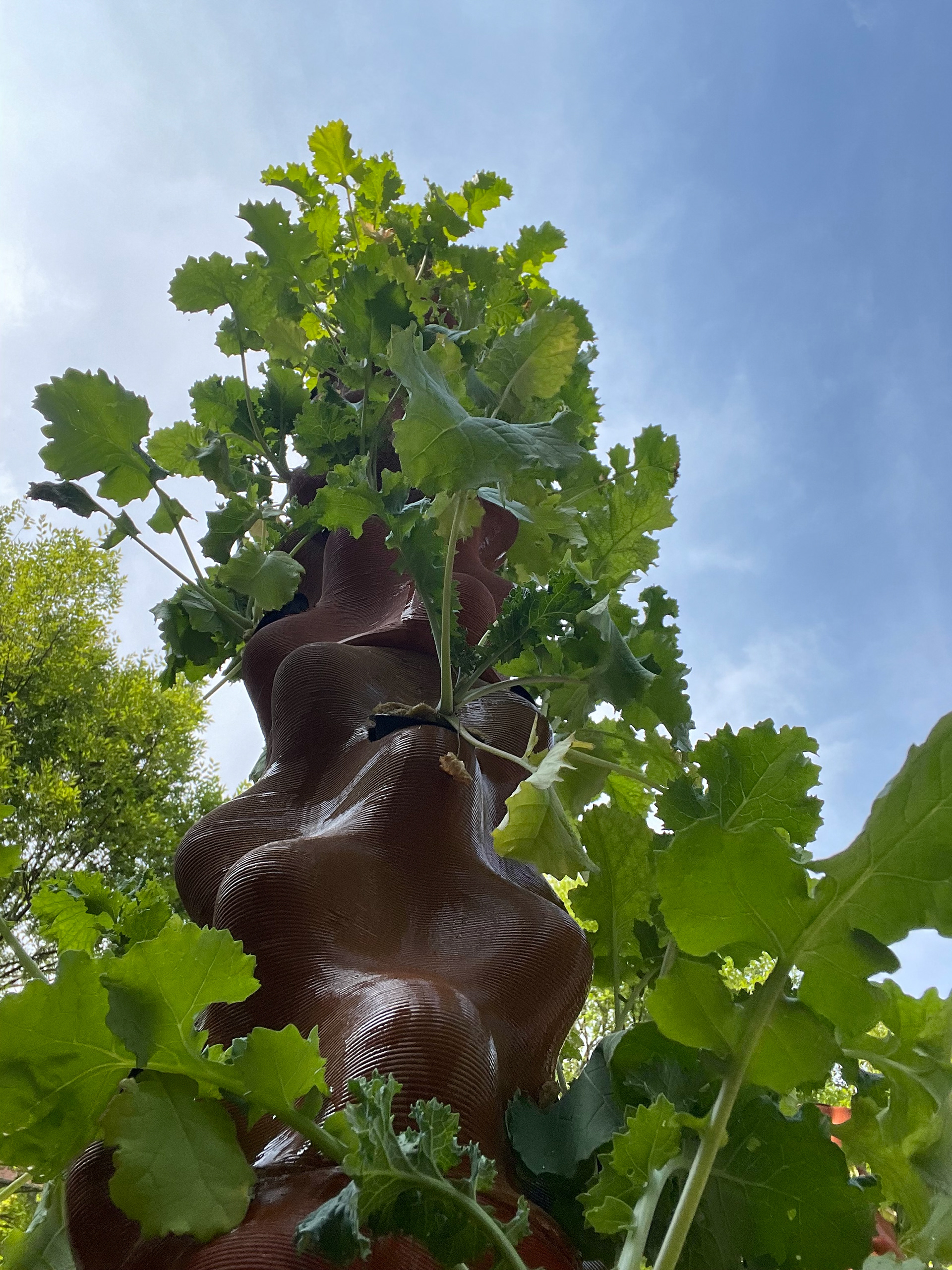ClayPonic V1 configures itself as an alternative verticulture (vertical farming), where plants are housed in ceramic 3D-printed multilevel towers. The system integrates solar-powered atomizers to recycle and deliver nutrient-rich water to the roots of the plants. Micro-droplets of water are periodically circulated in a low-pressure and closed loop configuration to create a rich misted environment inside the ceramic towers conducive to the plants’ growth. Within this innovative approach, which leverages the aeroponic concept, plant roots are suspended in the air inside ceramic 3D printed enclosures, receiving periodic sprays of a nutrient-dense solution. While technically the roots of the plants are openly hung in the air inside the hollow ceramic 3D-printed growing champers, the leaves are exposed to the indoor/outdoor ambient environment for a better photosynthetic response.
ClayPonic V1 multilevel 3D printed ceramic structures
ClayPonic V1 is a continuation of non-soil farming technology evolution, offering yet another promising solution by facilitating the growth of healthy food locally, especially fruits and vegetables. This pioneering farming technique breaks away by entirely dispensing with traditional growing mediums, opting instead to nourish plants in custom ceramic 3D printed substrates that are biofilm accommodative, deployable and architecture integrative.
ClayPonic V1 is a model to localize food production and perpetuate food self-sufficiency
ClayPonic V1 enables year-round cultivation with minimal water and nutrient consumption by maximizing plant nutrition assimilation and accelerating growth. The deployability merit of the model facilitates its placement and integration into the built environment in urban centers and around human settlements, reducing transportation costs and bolstering local economies. The verticultural configuration of the model and its soil-free nature significantly reduces risks of soil-borne diseases, pathogens, and pests. This revolutionary approach to farming efficiency improves agricultural practices and reduces dependence on chemical pesticides and herbicides, promoting eco-friendly farming principles.
Ceramic 3D printed water reservoir prototypes
Water culture and working air concept: water circulation and nutrient uptake
ClayPonic V1 introduces additively manufactured clay hydroponics as a promising soilless agriculture technique, fostering a dialogue on urban farming and food self-sufficiency. By harnessing the power of technology and innovation, this project, the first in a series of technology implementations, integrates machinery, materiality, and ecology, aspiring to create deployable systems capable of addressing pressing challenges while deepening human connection to the natural world.
Ceramic 3D printed water reservoir prototypes
ClayPonic V1 takes advantage of a novel, inexpensive, and locally harvested clay as a prime material for fabrication. Clay is low-cost, widely available, and environmentally benign with little to no ecological footprint. A key advantage of the material in juxtaposition with additive manufacturing lies in the unparalleled design and production flexibility. Perhaps the most favorable attributes that align with clay’s potential benefits for plant growth and development is its physical, chemical, hydraulic, and geological composition properties. The slow absorption and release of water by ceramic helps maintain a level of moisture in the rhizosphere, preventing both waterlogging and drying. This reduces water circulation frequencies and over-reliance on atomizers. Its aeration porosity helps to oxygenate plants’ root zones. Furthermore, clay’s ability to enhance plants’ nutrient uptake is superior to that of other commonly used materials in hydroponics.
Introducing 3D printed ceramics as growing mediums along with the working air maintains a high rate of photosynthesis by managing oxygen levels in the air and around the plants. This condition, coupled with the uniformity of nutrient concentration in the water droplets and pH values accelerates plants growth. The presence of minerals inherent in the clay body can supplement nutrient deficiencies in the soil, contributing to improved crop quality and resilience against environmental stressors. The comparative advantages of clay, in general, over commonly used plastic and other mediums in supporting plant growth warrant exploration regarding their impact on nutrient and oxygen delivery as well as photosynthetic performance.
ClayPonic V1 integrates architecture and speculates on the wider implications of the system in the built environment
The introduction of the system as a meditative space amplifies its impact, inviting individuals to engage with nature in a contemplative and immersive manner. Clay 3D Printed Hydroponics offers a wide spectrum of therapeutic experiences by communicating to the soul, mind, and spirit of our bodies through multitudes of sensations: sighting, hearing, smelling, touching, and tasting – the five human senses. From the moment individuals encounter the system, whether in an educational setting or a public space and horticulture garden, they are fully involved in a sensory experience that transcends mere food production.
Visual engagement emerges as a key element of this urban farming model. The vertical configuration of the garden optimizes space and creates a captivating showcase of ceramic elegance and lush greenery. By including a range of plant types including ornamentals and edibles, the pavilion caters to our aesthetic sensibilities while also promoting both biodiversity and food choices. The system not only stimulates touch sensory but also dictates physical engagement through transplanting and harvesting. The system offers olfactory stimulation through the cultivation of fragrant plants. When people engage with the garden, they can smell the scents of herbs and flowers, enhancing their journey and heightening their sensory experience, creating a stronger bond with nature. The auditory dimension allows people to enjoy the musical sounds of water trickling through the ceramic structures. Such spiritual sound not only enhances the ambiance of space, but also acts as a gentle nudge and reminder about the system’s dependence on water — a valuable resource that needs careful handling and preservation.
